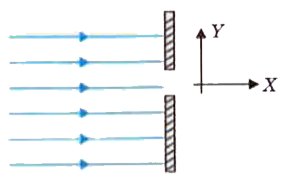A parallel beam of electrons , travelling in x - direction , falls on a slit of width d (see the figure) . If after passing the slit, an electron acquires momentum in the y direction, then for a majority of electrons passing through the slit , (h is Planck's constant)

The correct Answer is:A
Step by step video & image solution for A parallel beam of electrons , travelling in x - direction , falls on a slit of width d (see the figure) . If after passing the slit, an electron acquires momentum P_y in the y direction, then for a majority of electrons passing through the slit , (h is Planck's constant) by Physics experts to help you in doubts & scoring excellent marks in Class 12 exams.
Updated on:21/07/2023Topper's Solved these Questions
Similar Questions
A parallel beam of gren light of wavelength 546 nm passes through a slit of width 0.40mm. The transmitted light is collected on a screen 40 cm away. Find the distance between the two first order minima.
View SolutionA beam of electronis as YDSE experiment . The slit width is d when the velocity of electron is increase , then
View Solution
Knowledge Check
A parallel beam of electrons travelling in x-direction falls on a slit of width d (see figure). If after passing the slit, an electron acquires momentum py in the y-direction then for a majority of electrons passing through the slit (h is Planck's constant):
 A∣∣Py∣∣d>hB∣∣Py∣∣d<hC∣∣Py∣∣d=hD∣∣Py∣∣d>>h
A∣∣Py∣∣d>hB∣∣Py∣∣d<hC∣∣Py∣∣d=hD∣∣Py∣∣d>>hA parallel beam of electrons travelling in X-direction falls on a slit of width d (see figure). If after passing the slit, an electron acquires momentum py in the Y-direction, then for a majority of electrons passing through the slit (h is Planck's constant):
 A∣∣py∣∣d=hB∣∣py∣∣d>hC∣∣py∣∣d<hD∣∣py∣∣d>>h
A∣∣py∣∣d=hB∣∣py∣∣d>hC∣∣py∣∣d<hD∣∣py∣∣d>>hThe direction of a cathode ray particle passing through a magnetic field can by found by
AFleming's left hand ruleBLaplace's lawCMaxwell's cork screw ruleDAmpere's rule
An electron is travelling along the x-direction. It encounters magnetic field in the y-direction. Its subsequent motion will be
View SolutionAn electron is travelling along the x-direction. It encounters a magnetic field in the y-direction. Its subsequent motion will be
View SolutionA parallel beam of light of wavelength λ passes through a slit of width d. The transmitted light is collected on a screen D aways (D>>d). Find the distance between the two second order minima.
View SolutionA parallel beam of light of wavelength 4000Å passes through a slit of width 5×10−3m. The angular spread of the central maxima in the diffraction pattern is
View SolutionA parallel beam of light of wavelength 4000Å passes through a slit of width 5×10−3m. The angular spread of the central maxima in the diffraction pattern is
View Solution
